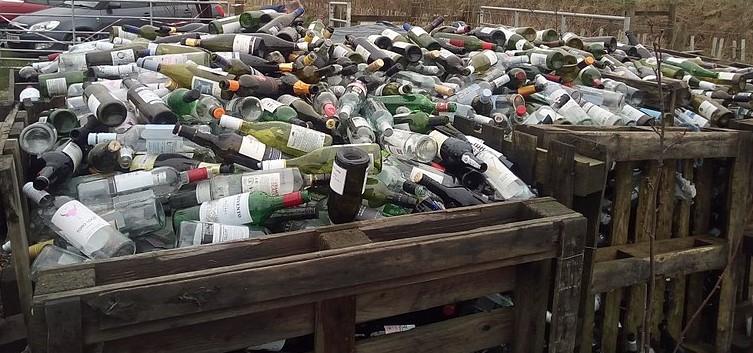Glass bottle foundation

|
| These bottles were used as insulation for the Round House floor at Whistlewood Common in Melbourne, Derby, United Kingdom. |
Contents |
[edit] Introduction
Glass bottles can be used as part of a sturdy foundation to trap a layer of air between the ground and the finished top surface. This creates a layer that is naturally insulated and waterproof. It is also well protected from rats and other pests that could otherwise tunnel under the floor.
This is not a new method of construction. Like other methods of construction that used glass, glass bottle floor foundations are well documented from Victorian times. More recently, glass bottle flooring foundations have experienced a spike in interest due to their effective reuse of glass bottles. The method is also popular for self-build projects when DIYers are looking for alternative waste reduction options.
There are two basic methods of creating a glass bottle floor foundation.
[edit] Bottles and sand
For this method, the rough earthwork is first layered with sand, gravel or other loose, natural material. The unbroken glass bottles are then placed in neat rows either nose down or side by side in alternating directions on top of the rough earthwork. This is then covered with another layer of sand over the bottles.
Next, a layer of protective sheeting is used to cover the sand. This layer can be something as simple as plastic sheeting or another material (such as a geotextile membrane or a different form of damp-proof membrane). The purpose of this layer is to help prevent moisture from coming up from the ground.
Finally, concrete or a similar substance is poured over the protective layer to create a floor that is strong and protected from cold and damp.
[edit] Method two: bottles and concrete
Another method of construction is to place a layer of wet concrete on the rough earth and then position the bottles side by side on top of the concrete. The bottles should not touch - there should be a small gap between each bottle. The bottles are then pressed down gently into the wet concrete.
A second layer of wet concrete is then spread over the first layer and the bottles. The top layer of concrete should be pressed between the bottles with another layer of concrete on top. Another layer of side by side glass bottles is added - this time staggered over the first layer.
This method continues until the floor has reached the desired height. The final layer should be at least two inches thick to provide optimum strength.
Empty glass bottles are strong enough to withstand sand or concrete being placed around them. The reused glass bottles trap air and create an air pocket in the concrete which helps keep the floor insulated from cold that would otherwise come up from the ground.
[edit] Related articles on Designing Buildings Wiki
Featured articles and news
The UK's Modern Industrial Strategy: A 10 year plan
Previous consultation criticism, current key elements and general support with some persisting reservations.
Building Safety Regulator reforms
New roles, new staff and a new fast track service pave the way for a single construction regulator.
Architectural Technologist CPDs and Communications
CIAT CPD… and how you can do it!
Cooling centres and cool spaces
Managing extreme heat in cities by directing the public to places for heat stress relief and water sources.
Winter gardens: A brief history and warm variations
Extending the season with glass in different forms and terms.
Restoring Great Yarmouth's Winter Gardens
Transforming one of the least sustainable constructions imaginable.
Construction Skills Mission Board launch sector drive
Newly formed government and industry collaboration set strategy for recruiting an additional 100,000 construction workers a year.
New Architects Code comes into effect in September 2025
ARB Architects Code of Conduct and Practice available with ongoing consultation regarding guidance.
Welsh Skills Body (Medr) launches ambitious plan
The new skills body brings together funding and regulation of tertiary education and research for the devolved nation.
Paul Gandy FCIOB announced as next CIOB President
Former Tilbury Douglas CEO takes helm.
UK Infrastructure: A 10 Year Strategy. In brief with reactions
With the National Infrastructure and Service Transformation Authority (NISTA).
Ebenezer Howard: inventor of the garden city. Book review.
The Grenfell Tower fire, eight years on
A time to pause and reflect as Dubai tower block fire reported just before anniversary.
Airtightness Topic Guide BSRIA TG 27/2025
Explaining the basics of airtightness, what it is, why it's important, when it's required and how it's carried out.
Construction contract awards hit lowest point of 2025
Plummeting for second consecutive month, intensifying concerns for housing and infrastructure goals.
Understanding Mental Health in the Built Environment 2025
Examining the state of mental health in construction, shedding light on levels of stress, anxiety and depression.
The benefits of engaging with insulation manufacturers
When considering ground floor constructions.
Lighting Industry endorses Blueprint for Electrification
The Lighting Industry Association fully supports the ECA Blueprint as a timely, urgent call to action.

























Comments
Excellent paper here! Thanks, David Benjamin